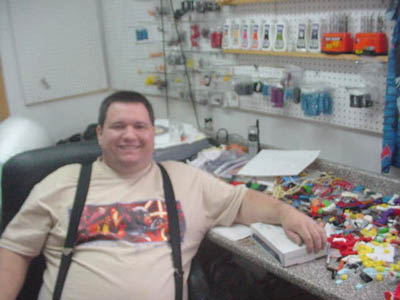
CM: Let’s start by talking about Paul Clarke and not “Doc Mego” first. Where were you born and raised?
PC: I was born and raised in Nassau County Long Island – about 30 miles from Manhattan. First we lived in Mineola, then Floral Park. Two towns about 5 miles apart and virtually the same.
CM: What can you tell us about your childhood in general? (Brothers and sisters? What kind of kid were you?, Imaginative? Factual? Intense? Easy going?
PC: I could tell you blood-curdling stories – but my throat’s a little dry. (The Quiet Man)
I was the sixth of seven children – 3 girls followed by 4 boys. Sharing a room with my brothers taught me some very important life lessons: there is no justice, pain can be tolerated, and if you break a chair fighting – set it back up and wait for your drunk brother to come home after lights out. BOOM!! “Hey Dad – Peter just broke the chair!”
I was too tightly wound as a kid – and spent most of my time daydreaming. I was an average to poor student in school, it was a lot of work just to pay attention. I was always drawing super-heroes in my notebooks. All those white clean pages with their neat blue lines just cried out to be the scene of an epic battle between Batman and the Joker.
I discovered comic book in the barber shop as soon as learned to read or even earlier. I can still remember the first time I saw Spider-Man – it was the ’67 TV show, although I did know Superman and Batman – probably from the live action TV shows.
I have noticed that kids fall into two categories – figure guys and vehicle guys. Figure guys are most interested in the hero myself – be it Batman, GI Joe, or Darth Vader.
What the hero travels in is nice, but less important. The vehicle guys really get excited at the accessories – the Batmobile, the jeep, Adventure Team HQ, or the tie fighters. Vehicle guys are also into Lego, trains, or radio control cars.
Most Mego collectors are figure guys. We don’t build table top Batcaves or cities (as much as we might want to) we usually display our Megos on a bookshelf or on the wall.
CM: Tell us about little Paul and Mego. Do you remember your first? Did you have a lot of mego as a kid? How did you get them? Christmas only? Birthdays? Rewards for good behavior? Was it a big deal or just another toy? Did you beat the crap out of them? Did you learn to repair them? Switch parts to make new Characters? Etc…
PC: Mineola had a 5 and dime store called Big D – as in big discount! I distinctly remember seeing a kid in the neighborhood playing with a Captain Action Batman and I was mesmerized by the gold foil emblem and the idea that there was a kid-sized Batman!
My mom went to Big D with my brother Jeff and I - both devoted Batman TV show watchers – and there are the shelf are the six World’s Greatest Super-Heroes in the white cardboard box
.
I stood there trying to decide between Superman and Batman – Batman or Superman –
Mom would only let me get one. Jeff always played Robin since he was a year younger than me, and he was willing to get Robin, so I choose Batman – both of them had removeable masks but were window boxes.
That night I sat and stared at the galleries on the side of the box. I didn’t know who Shazam was, and Aquaman and Tarzan were nothing special, but I regretted not getting Superman. Batman was cool and all, but Superman was the MAN!! The red and blue costume just jumps out at you – the yellow box was so bright. Batman had a pink box and Robin’s box was some weird shade of green.
The next day or the next week – however long it took me to convince my mom she needed something from Big D – I got a Superman. That was the beginning of my Mego collecting. My brother Jeff gave up on megos and super-heroes not long after, but I was hooked for life.
After that, I had to “collect ‘em all” – birthdays, Christmas, rewards for being good, it all went to either comic books or megos. The best was Christmas 1974 – I got the Batcave, Batmobile, and the Joker and Penguin. Before Christmas we were given the JCPenney catalogue and could pick out $25 worth of merchandise. I keep the Mego page from that catalogue framed on my wall today. I can still remember opening the packages that morning and seeing the Batcave box. I think I probably got a new Batman and Robin that day too since the RC versions had not survived the move to Floral Park.
CM: Any particular childhood Mego stories that stand out?
PC: Lots of them – I taught myself how to sew with a needle and thread because the snap on Spider-Man’s costume came loose. My mom told me to “put it in her sewing pile” which meant that it would never be fixed, so I found some red thread and a needle and after several tiny wounds to my thumb, got the snaps secured again.
I wrote a letter to Mego Corporation in 1974 telling them to make Star Trek figures of Kirk, Spock, McCoy, Scottie, and the Klingon. Some of my brothers got hold of the letter and teased me mercilessly about it. So I tore up the letter and sulked off. A few months later, I was stunned to see the same figures in Big D.
To this day, my brother-in-law of 30 years will tease me saying “Dear Sirs: My name is Paul Clarke, I am ten years old, and my Spidey’s arm broke. Send me a replacement immediately or I will call the Better Business Bureau.” I got my revenge though – his son works with me making repros and thinks it’s the greatest job in the world.
CM: Was there a time when you “outgrew” your toys and got rid of them all?
PC: When I started seventh grade in 1977 (Catholic schools don’t have junior high) my mother demanded that I stop playing with dolls and get rid of all my toys. She was afraid that my peers would think I was “odd”. So I had to give all my toys to my friend’s brother who quickly destroyed them all.
CM: When and how did you rediscover Mego? (how old were you, how did it happen, how did it “hit you”?)
PC: I started dating my wife in 1981 at the age of 17. For my eighteenth birthday she gave me a Mego Superman, Spider-Man, and Captain America (all on cards). They were still being sold in Toys R Us for $3.99. She knew I liked comic books, so she thought I might enjoy these toys. I was speechless, well not really – “you got me MEGOS!!!” As you can guess, my mother was not thrilled about it, but at least I had a girlfriend, even if she was from Queens (inside joke).
CM: What was your response? Did you become an addict? Buying up all you could at the time?
PC: If I had any sense, I would have bought up every stray, discounted Megos – but few people have the presence of mind to see future scarcity when the thing is all around you. It wasn’t until after we got married in 1988, after seeing the Kenner Super Powers come and go so quickly, that I started to buy loose Megos for $10 each. They wanted $40 for boxed ones – but that was just way too much to spend on an old toy.
CM: Tell us about how it was trying to collect complete figures when you got into it. You were collecting pre-ebay, right? Tell us about how you found stuff, how you communicated with other collectors, early internet lists and contacts, etc…
PC: In the wild days before ebay, I used to see bins of Megos at shows and flea markets.
There was one old guy at the Roosevelt Raceway Flea Market that was still buying carded Megos in Canada during the week – along with other toys – and selling them at the flea market on the weekend. Spend $50 with a flea market vendor and he’ll name one of his kids after you. This guy was searching discount stores in Canada for any Mego I asked for. Too bad I didn’t even know about the knights, pirates, or Robin Hood. I was strictly a super-hero guy.
My mom never let me get any of the girls growing up – for fear I would undress her and become some porn-consuming pervert – good thing that never happened!
So now that I was a respectable married adult, I could buy my own Batgirl, Supergirl, Wonder Woman, etc.
I remember going to a small comic and toy show once and seeing a guy with a table full of loose Mego parts – like you still see today with the GI Joe collectors. A few years later, when I found out I wasn’t the only grown man buying old toys, I tried to find this guy again – without luck. That was when I realized that parts were important.
CM: When you first started, did you customize figures? If so, what possessed you to do so?
PC: Speaking of possession, I remember customizing one of the SWAT guys into the Son of Satan when I was eleven after reading the Marvel Spotlight comics with great Romita covers. John Romita (Sr.) can make anybody look great. He has been responsible for more kids buying a Marvel comic based on the cover, then opening it up to find out the art was Frank Robbins or Gil Kane – oh the disappointment!
I think most customizers are comic fans. Comics are great for showing the same basic design elements with slight variations in different color schemes. Once you have the extra bodies and costumes necessary for customizing, it’s not a great leap to put this head with that bodysuit and those boots. Next thing you know you find yourself making Captain Marvel Jr.
CM: Now let’s talk about the birth of Doc Mego. There was something that made you cast your first part. What was it? Tell us about what it was like when you first started making reproduction parts. I’m guessing you had to basically invent the processes yourself, and that there were no internet how to’s and such. How did you figure it out?
PC: I needed a Batman glove – it was that simple. Batman with one glove looks like a loser.
No millionaire playboy or world’s greatest detective would be caught dead with only one glove! I stumbled across the blue vinyl in a dollar store and made a template of my one existing original, then cut out the vinyl and glued the two sides together. After six tries and several hours, I managed to make a pair that only had glue on the edges.
I solved my problem and had a viable substitute for my Batman until I found a permanent replacement.
CM: Why did you first start to reproduce? Just for yourself, or were you thinking sales potential?
PC: I had been kicking around the idea for a few years before I discovered the Mego Museum in 1997, but I could not motivate myself to do it just for my own collection.
Once I realized that there were other grown men out there who needed a glove or a cape to fix up their figures, I pulled out my experiments in plaster of paris and clear coat resin.
Like anybody, I hoped that there were millions of guys like me and that it would be a great money maker. But more importantly, it was a chance to spend more time with my beloved Megos and understanding what went into making them.
The first actual part I reproduced was Thor’s hammer. The plaster mold dried and shrunk around the hammer so I ended up breaking the original hammer to get it out. Then I cast a hammer that came out looking more like Fred Flintstone’s hammer than Thor’s. I went to every hobby shop and art supply store on Long Island asking for help, but no one had any experience or clue. I bought some silicon rubber one day to try. It looked like marshmallow fluff and stank to high heaven, but it made a decent mold material.
Now I could make a hammer that looked like Thor’s.
CM: Were you selling parts before you had things made in China? If so, how did the selling get started, who did you sell to, and how did you make sales with the internet as it was?
PC: In those days we communicated with each other through Robert Levy’s e-mail list.
It was the pre-courser to Yahoo groups – and it cost Robert a lot of money to do it.
I posted that I was making reproductions of the vinyl gloves and capes if anyone was interested.
Originally I was thinking of charging $1.00 a pair, but my wife asked me what my reaction to that offer would be, if I was not making them. I said I would send the guy a twenty and get a lot of them in case I needed them at a later date. She made me realize that it was going to take me a lot of time to make them, so I should charge $5.00 a pair to make it worth the time lost – and to keep demand manageable.
It was never intended to be a full-time gig. It would have been great, but I know that while most kids who grew up in the 1970s played with Megos, the percentage of those who became adult collectors was much much smaller.
CM: What was your product line back then? What was easy, what was trouble to make, how did you overcome those troubles. What kind of discoveries did you make and how did you make them?
PC: I was sewing capes on the train to work every day and usually on the ride home as well.
During one train ride, the guy next to me asked what I was doing. I looked at him and said “Minding my own business – what are you doing?” That was the end of that conversation. A few times I’ve tried to explain to strangers, but it’s never worth the trouble. Either you get it or you don’t.
The gloves had to be made at home – I modified a soldering gun to make the gloves a little faster, but it still required going over very millimeter with a second gun, so it still took me an hour to make a few pairs.
Casting belts and heads came next. Heads were easier because they were solid, but the mass often affected the shade of the color. I remember once putting some heads on a shelf because they felt a little gummy after de-molding. The next day those same heads were blobs of dripping goo. I still don’t know exactly what went wrong there.
Some days I could cast belts that were flexible as rubber, other days the same belt would snap like a twig. I spoke to different manufacturers about it and the only response I could from them was “the product was not made to do that – we can’t tell you why it’s happening, but we can’t support your results. You’re on your own.” Great customer service.
I keep logs of measurements of materials, amount of colorant added, type of colorant, temperature, humidity, time of day, time of year, even wooden stirrer or plastic. After two years, I found out what the X factor was. Now I can replicate the conditions I need on demand – well, most of the time.
CM: When did the name “Doc Mego” come into play? From the beginning of your sales and site, or was it a nickname that just stuck?
PC: I used to offer to re-string type 1 bodies for people. I was fixing Megos, so I called myself “Dr. Mego” – back on Levy’s list, we were all making up nom de plumes like Imp and Palitoy. I liked it because it had a real comic book sound to it – like Dr. Fate or Dr. Doom. Of course it was inevitable that people would go with the more friendly and folksy Doc Mego.
CM: In the Mego community, what is the percentage of people that actually call you “Paul”. So many people think of you as Doc, that some may have forgotten you have a name.
PC: Well, there’s a flattering comment. “Did your mother name you Doc?” It is funny to answer the phone and hear someone sheepishly ask for Doc Mego or the Mego Doctor, but most people call me Paul – but growing up in a big family, you answered to “hey you” or “what’s your name” as often as your own name. Our motto was “Call me anything but late for dinner.”
CM: Tell us about China. What made you start to investigate getting repro parts made in China? How did you get set up and make the connections? How did you finance the first order and what were those items? What was your reaction when the first shipment came? What was the mego community’s reaction?
PC: A customer of mine had a contact in China. I barely knew him – although he was, and is, a very nice guy. I still try to chat with him whenever possible. My family warned me not to get involved with China, since I had no legal recourse if they just took my money and split. So as usual, I talked to my wife about it. She agreed to let me get a home equity loan on our house to finance limited production. First we did non-molded items like gloves and capes. They arrived looking good. Then we tooled some simple belts in the same color. It took a little longer for them to arrive but the quantity was good, although I wasn’t thrilled about the translucent look.
After that, we decided to take the big leap and tool the male body since that was at the heart of customizing and I was finding it harder to find cheap vintage bodies since ebay had taught every flea market vendor that calling him Starsky or John Boy meant that you could ask $15 instead of $5.
I wired $5,000 to China and waited. After six weeks, a resin blue body arrived via FedEx. It was a thing of beauty and almost exactly like a vintage Mego. I had to send that body back to China since it was a prototype, so I had nothing to clutch in my sweaty hands while I waited another two months for the real bodies to arrive. The balance of the tooling was paid off by adding x amount to the first five thousand bodies.
First I got some sample parts to look over. The color of the body was more Asian than Caucasian, so I had to look up a PMS (Pantone Matching System) color that would get close to the right skin tone. But one thing I did notice was that China had made changes to the design based on e-mail exchanges that I thought was idle comments. I had said that the knee pins were always breaking, so they made it one solid piece so that there was no pin to break. The wrist and ankle pins had heads on them so they wouldn’t slip out.
But the biggest improvement was making the arms and legs solid with PVC instead of the hollow paraffin type plastic that Mego used. This allowed the hands to bend without breaking, and the feet would never crack in two.
One day I came home to find 20 boxes stacked in my driveway. I cut open one of the boxes and started laughing like a mental patient running my hands through dozens of new naked and headless bodies. Suddenly I realized that my wife was silent next to me. I sheepishly looked at her and said “how are you going honey?” She gave me the thumbs up and said “cool”. It felt just like the day I got the Mego Green Arrow. He was the first type 2 body I had ever seen. I sat for hours that day staring at the torso – it was a vast improvement over the scrawny type 1 body. Type 2 was the body of a super-hero.
Now I had 2,000 of these bodies in my driveway – the days of scarcity were over.
CM: How did china affect your hand casted parts sales.
PC: The China made parts definitely “raised the bar” on quality – since most orders are a combination of China and handmade parts. Of course we would all love it if everything could be made in China, but then you couldn’t ask for custom colors.
CM: How do Doc Mego and Paul Clarke get along? Are there times you want to chuck the whole thing? Does being Doc get in the way of your real life? What does your family thing of all this? Is being Doc Mego a full time job or do you work a regular gig and then come home and play Doc? How does that work?
PC: Since I’m not schizophrenic, we get along fine. Of course there are days when I would like to be rid of my alter-ego, but most days I am thrilled to be able to provide a service to other collectors – and best of all – to see a kid play with something I made. The key to any side business or activity like coaching is balance. If I spent every night and all weekend away from home, then why do it.
I’m lucky to work for a guy who digs what I do as Dr. Mego. He doesn’t collect Megos, but he remembers them fondly. So he is willing to let me work some days from home so I can fill orders while processing data for his company. I have proven to be reliable and hard-working, so he can give me that flexibility. Some days I still have to go in for meetings, but I think he likes it better than when I used to make molds at my desk.
My wife and daughter have their own play time – like stuffed animal tea parties or bath time, so that when I slip away to do some work, they don’t miss me. As long as I’m there for goodnight kisses, everything works out.
When I told my parents about the idea of making replacement parts for 30 year old toys, my mom said “if it’s a good idea, why isn’t someone else already doing it?” I keep that thought in mind.
My family has always thought that I am a fool who lives in a dream world. No one in my family, aside from my brother Jeff, has ever understood my love of Megos. I showed my dad the Toy Shop article about the new Star Trek figures, but he didn’t bother to read it.
He flipped through the rest of the magazine and tossed it aside.
CM: As the reproduction parts King I’m guessing you are hero to some, villain to others. How, in general, has becoming Doc Mego affected your relationships in the mego community?
PC: When I first started doing this, I think most people thought it was a good idea. If they didn’t, I would not have continued making replacement parts.
Everyone I have ever met in the Mego community is very nice to me – whether or not they agree with me. It is so terrific to find people who share our peculiar little hobby – the GI Joe guys don’t get the bright colors, the Star Wars guys don’t get the cloth costumes. Even among adult toy collectors, we are unique.
One of the fringe benefits of doing this is that I get to talk on the phone with a lot of Mego collectors – it’s always a good experience. I will do all I can to help promote live meetings or projects like Robot Chicken that will bring new people to Megos.
I can’t control what other people think about what I do. The comedy is that some of the same people who publicly dismiss repros, will contact me privately to buy things. That’s fine with me – like a priest or a hooker – I keep the confidentiality of my patrons
CM: What is the biggest downsides to being “Doc Mego”?
PC: People think of me as a real-live Santa Claus. A friend said to me once that every time someone opens a package from me – it’s Christmas day 1974 all over again. That’s a lot of responsibility to carry. If the contents of that box disappoint you – it’s a lot more of a bummer than Land’s End sending you the wrong shirt.
What is a little hard sometimes is the perception that my opinion carries more weight than someone else’s. I’m just another 40something who geeks out when I see a Mego.
It is really great to have a place like the Museum to actually be able to discuss the fine points of Mego anytime. Sometimes I just go through the galleries to bask in pure Mego joy. The only thing that would make it better is 3-D holography.
CM: What are the biggest upsides?
PC: Every time I pull a piece out of a mold, especially making something in a color it was never made in, it is as cool as opening a birthday present. Also when a customer tells me that his collection is better off because of my parts or because he was able to realize a custom figure he always wished Mego had made – that makes it all worthwhile.
CM: What’s coming up for Doc Mego? New products? New toy lines? Anything you can share? (we talked just a bit about this at Megomeet, and the thing with James Brady- Anything you can share in a public way or at least hint to?)
PC: Did you know that I am making new Star Trek Megos for Diamond Select Toys?
I’m worried that I haven’t been diligent enough about telling people. Even wrong numbers and spammers find out I AM MAKING NEW STAR TREK MEGOS!!!
If these first six figures sell well, I am hoping Diamond will let us explore some new characters that Mego never made. James Brady will be sculpting those heads if and when that day comes.
In the meantime, James has sculpted four heads based on the 1968 movie Night of the Living Dead. These figures are being made for Avatar Press in time for Halloween.
CM: What’s coming up for Paul Clarke, outside of the toy world?
PC: We have put in the paperwork for adopting another little girl from China. Given the current waiting time, I expect we will travel to China in summer of 2008 – just in time for the Beijing Olympics! This time we plan to skip the Forbidden City tour (ask me about it sometime) and visit my manufacturer in Hong Kong – unless there is another outbreak of SARS like last time.
Beyond that, I figure in 2012 a giant tsunami will flood most of the east coast of the U.S. If my family and I are asleep for it, then one day divers will find the strangest find in the history of archeology – thousands of pairs of little plastic parts floating throughout the house. If not, then I guess I’ll raise my two girls on Long Island and teach them how to sew very small clothing. Whenever Gwen comes into my shop, I tell her: “One day, all this will be yours!”
CM: With all this DM stuff, are you still a collector? Would love to see pics of your collection.
PC: So would I. Actually I finally got most of my own Megos out of the boxes from last year’s construction project and will e-mail some pictures for the Museum.
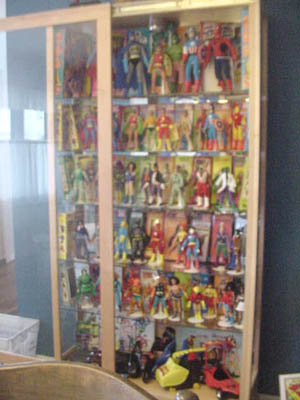
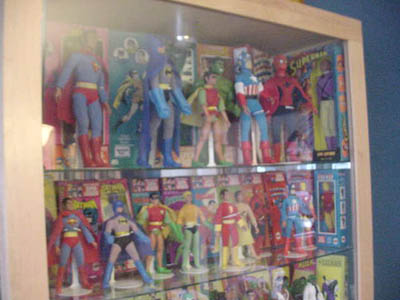
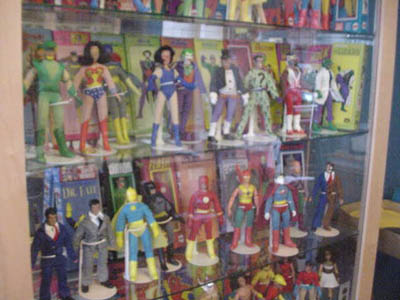
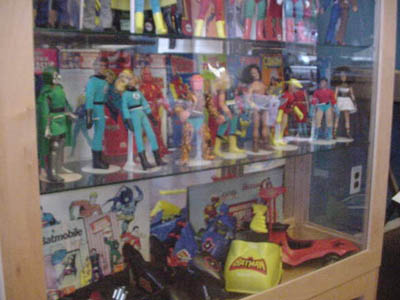
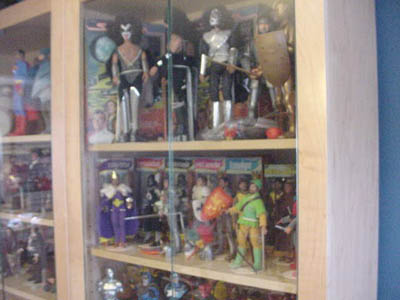
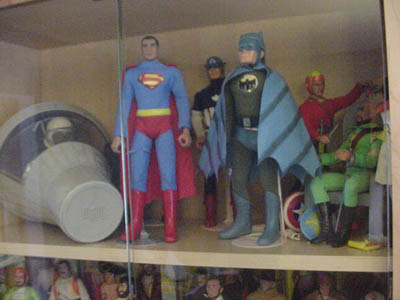
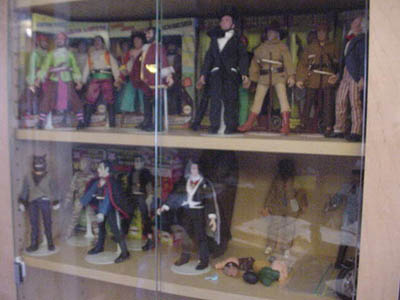
CM: What is the most enjoyable part of being into Mego for you?
PC: That brief second where you are seven years old again – flying a Superman around the room, or sliding Spider-Man down a string to land across the room. I can still get that feeling when I get a boxed Mego in the mail or roll a Batmobile across a wood floor.
It only lasts for a second, but it is the coolest feeling in the world.
My inner child and I spent a lot of time together.
CM: When did the name “Doc Mego” come into play? From the beginning of your sales and site, or was it a nickname that just stuck?
PC: I used to offer to re-string type 1 bodies for people. I was fixing Megos, so I called myself “Dr. Mego” – back on Levy’s list, we were all making up nom de plumes like Imp and Palitoy. I liked it because it had a real comic book sound to it – like Dr. Fate or Dr. Doom. Of course it was inevitable that people would go with the more friendly and folksy Doc Mego.
CM: Any random thoughts on things to add?
PC: I keep this saying on the wall in front of me.
“Nothing in the world can take the place of Persistence. Talent will not; nothing is more common than unsuccessful men with talent. Genius will not; unrewarded genius is almost a proverb. Education will not; the world is full of educated derelicts. Persistence and determination alone are omnipotent. The slogan 'Press On' has solved and always will solve the problems of the human race. “
-- Calvin Coolidge
CM: Thanks for taking the time to talk with us Paul! To keep up with all of Paul's labor's vist the Doctor Mego site.
